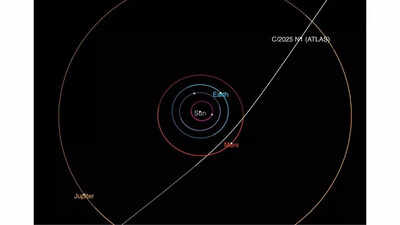An intriguing celestial object, believed to have originated from beyond our solar system, has been observed traversing our cosmic neighborhood. The object, designated 3I/Atlas (C/2025 N1), was first detected on July 2, 2025, by the ATLAS survey telescope in Chile. This marks only the third confirmed interstellar visitor, following 'Oumuamua in 2017 and comet 2I/Borisov in 2019.

Currently, the object is traveling at approximately 60 kilometers per second, positioned about 416 million miles from the sun. Its trajectory is hyperbolic, indicating an origin outside our solar system. NASA has verified that 3I/Atlas poses no threat to Earth.
The object, initially labeled A11pl3Z, was identified by the Asteroid Terrestrial-impact Last Alert System (ATLAS) in Chile. Subsequent observations by NASA and other facilities traced its path back to June 14, confirming its hyperbolic orbit, which strongly suggests an interstellar origin.
Named 3I/Atlas, it joins the exclusive list of confirmed cosmic wanderers, providing further evidence that such objects may be more prevalent in the galaxy than previously thought. The object is currently approaching the inner solar system from the direction of the constellation Sagittarius.
Initially classified as an asteroid, recent observations have revealed subtle signs of cometary activity. The Minor Planet Center has noted a faint coma and a short tail, leading to its dual classification as C/2025 N1.
Early estimates, based on its brightness, suggested a size of around 20 kilometers in diameter. However, experts now believe that the surrounding dust cloud may be inflating its apparent size, and the solid core is likely smaller. The object is expected to reach its closest point to the sun around October 30, passing within the orbit of Mars.
While its origin is remarkable, NASA assures that 3I/Atlas will maintain a safe distance from Earth, never approaching closer than approximately 150 million miles. As it approaches the sun, the object may brighten, potentially becoming visible through amateur telescopes in late 2025 and early 2026.
The Virtual Telescope Project plans to host a live broadcast for enthusiasts eager to observe this rare phenomenon. Scientists anticipate that studying this object will offer valuable insights into the composition and behavior of interstellar bodies.
Newer articles
Older articles
 Vijay Officially Named TVK's Chief Minister Hopeful for Tamil Nadu's 2026 Election
Vijay Officially Named TVK's Chief Minister Hopeful for Tamil Nadu's 2026 Election
 RJ Mahvash Prioritizes Work Over Buzz, Addresses Link-Up Speculation
RJ Mahvash Prioritizes Work Over Buzz, Addresses Link-Up Speculation
 JPG to PDF: A Comprehensive Guide for Graphic Designers & Professionals
JPG to PDF: A Comprehensive Guide for Graphic Designers & Professionals
 UNESCO's World Heritage Wonders: Unveiling 10 Iconic Sites, From Petra to the Pyramids
UNESCO's World Heritage Wonders: Unveiling 10 Iconic Sites, From Petra to the Pyramids
 iQoo Z9 Turbo: Rumored Specs Emerge – Snapdragon 8s Gen 3, 6000mAh Battery Highlighted
iQoo Z9 Turbo: Rumored Specs Emerge – Snapdragon 8s Gen 3, 6000mAh Battery Highlighted
 Shadman Islam Defends Bangladesh Batters After Day 1 Struggles Against Sri Lanka
Shadman Islam Defends Bangladesh Batters After Day 1 Struggles Against Sri Lanka
 England's Bold Claim: Could They Have Chased Down 450 Against India?
England's Bold Claim: Could They Have Chased Down 450 Against India?
 5 Often-Missed Warning Signs of Bladder Cancer You Need to Know
5 Often-Missed Warning Signs of Bladder Cancer You Need to Know
 KL Rahul Puts Country First, Prioritizes England Tests Over Newborn Child
KL Rahul Puts Country First, Prioritizes England Tests Over Newborn Child
 Tick Bite Paralyzes Fitness Influencer: A Wake-Up Call for Outdoor Enthusiasts
Tick Bite Paralyzes Fitness Influencer: A Wake-Up Call for Outdoor Enthusiasts